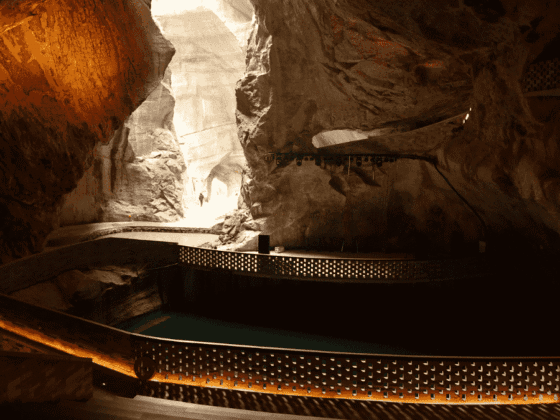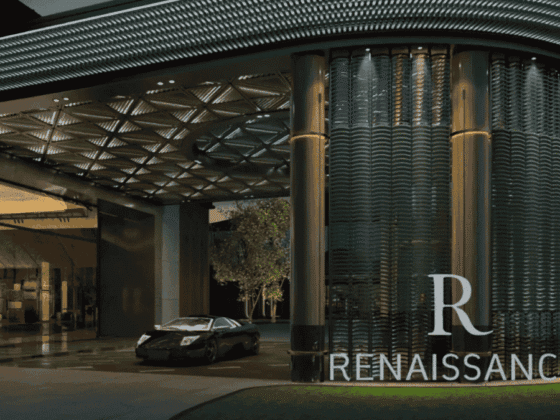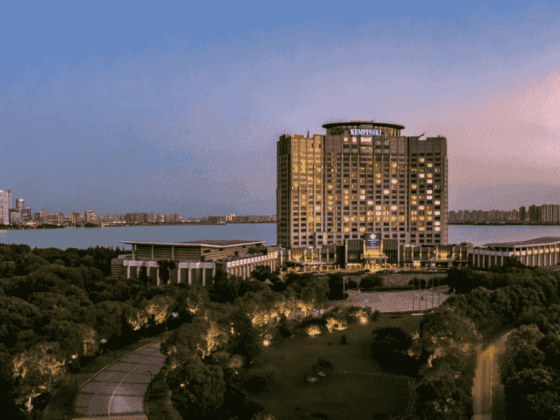
Tucked away in Wugong Village in Xiaozhongdian Township, Shangri-La Libraire Avant-Garde inhabits three traditional Tibetan dwellings that have been meticulously repurposed. These structures belong to a vernacular typology known locally as shanpian fang, a distinctive architectural form found across the cold, high-altitude plateaus of Shangri-La, where snow and rainfall are abundant. This is a building tradition rooted in the Tibetan agrarian-pastoral lifestyle—adapted sensitively to climate, topography, and available natural resources.

Unlike the enclosed courtyard homes of the Han Chinese, these Tibetan houses express a looser spatial rhythm, responding more to the vastness of the land than to the proximity of neighbors. Surrounded by rammed-earth walls that delineate the threshold between domestic life and nature—not between one household and the next—each structure appears to rise independently from the earth. The clusters they form across the Zhongdian basin orient loosely to the south, spreading irregularly across the plain. From the air, they resemble herds of yaks in migration.
The three houses of Pioneer Shangri-La Librairie Avant-Garde share this ethos. Though oriented generally southeast, each responds with subtle variation to the terrain’s natural gradient, which slopes gently from east to west. To minimize earthwork and respect the microtopography, every house adopts a slightly different axis. True to Tibetan carpentry, the buildings are constructed one storey at a time: apart from the few vertical members of the façade, the columns of each floor are structurally independent. The second storey, built for humans and deities, is symbolically elevated—its columns thicker and more commanding than those of the ground-floor animal stalls.
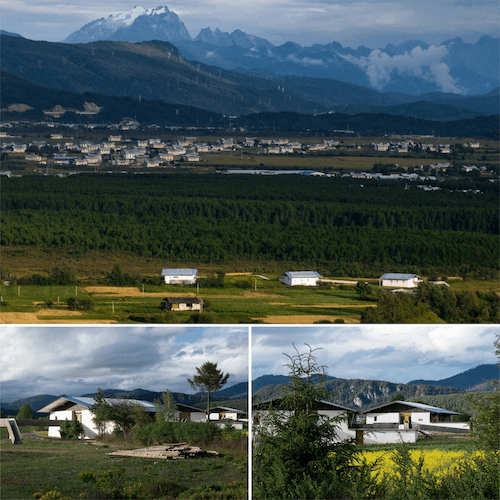
Design Strategy
Operating within a highly constrained budget, the design team chose to work with the original structural framework. Even if means had allowed for more, there would have been little justification to demolish and rebuild. Though aged, the timber skeletons showed no signs of rot or termite damage, and from a structural standpoint, remained robust and even redundant in strength.
These three houses preserve, almost intact, a visual and material record of Shangri-La’s pre-electrification pastoral life. We therefore saw it as both an ethical and cultural imperative to preserve them—not as static museum pieces, but as living heritage. Alongside the surrounding fields and grazing lands, they form an anthropological text, inviting future visitors and readers to inhabit and interpret this land through the lens of architecture. A Shangri-La Libraire Avant-Garde in such a place must, first and foremost, be a building of intellect.
Functionally, however, the greatest challenge lay in the roofing. The “shanpian” shingles—thin, wedge-split panels of native fir, harvested from Shangri-La’s dense alpine forests—are beautiful but fragile. Each plank measures roughly 2–3 cm thick, 20 cm wide, and up to 120 cm long. Their naturally grooved surface allows water to run off easily, but over time they decay. Local wisdom speaks to the burden of scale: the larger the ancestral house, the greater the strain on descendants, largely due to the cost and effort of maintaining these wooden roofs.
At Pioneer, years of abandonment had left the “shanpian” shingles riddled with damage. Rain and snow penetrated freely, leading to structural degradation—including the cracking of the rammed-earth walls. For this reason, most new Tibetan homes now adopt lightweight metal roofs, relegating “shanpian” to an ornamental or stylistic role.
The region’s climate poses further challenges. Winter arrives in November and clings on until April. Only in May does the plateau turn green again. The summer months—June, July, and August—bring frequent rain and thick cloud cover, often parting only at dusk. Even in mid-summer, the air can feel damp and cold. In contrast, winters bring sharp, piercing sun under vast blue skies. Modern Tibetan homes have embraced sunrooms as a standard feature—usually a glass enclosure over the southern courtyard, functioning as a passive greenhouse. This adaptation has become so widespread in Shangri-La city that it now defines the contemporary vernacular.
Inspired by this local innovation, we embraced it as the central strategy for reimagining the three Tibetan houses.
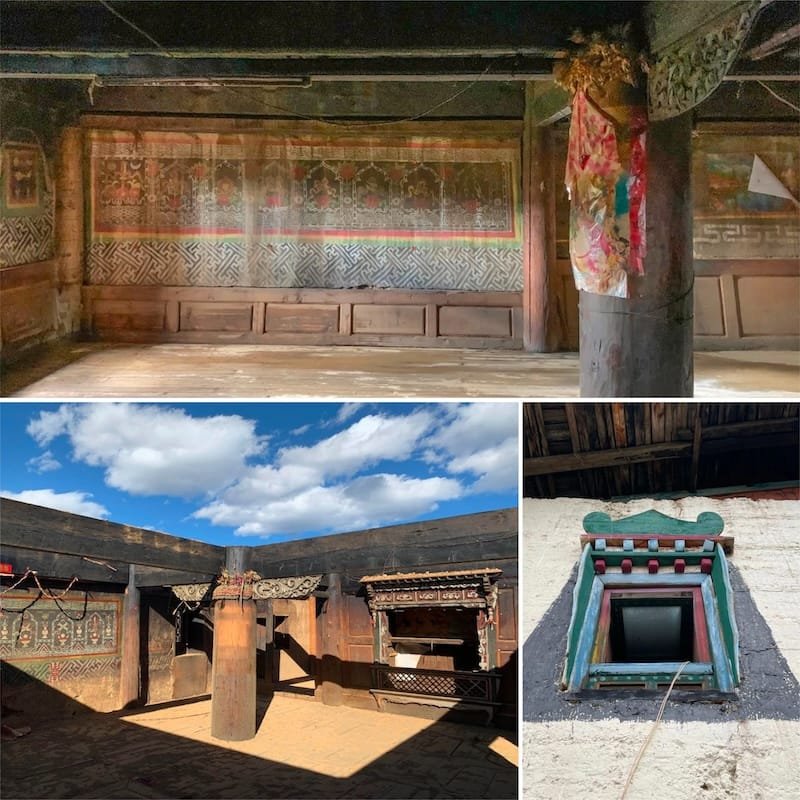
From House to Shangri-La Libraire Avant-Garde
To transform these domestic dwellings into a public cultural space, the first priority was light. The interiors were too dim, unsuitable for reading or gathering. Learning from the widespread use of sunrooms, we introduced a lightweight steel roof structure directly atop the original timber frames. Instead of wood shingles, we used translucent polycarbonate panels, allowing for adjustable transparency and fitted with automated curtains to modulate light according to weather.
The roof’s slope follows the original form, and its generous overhangs—essential for shielding the earthen walls from rainfall—were faithfully preserved. Externally, the buildings still appear deeply rooted to the land, but the new roof is visibly lighter. The once-shadowed interiors now bask in daylight; the everyday life of a Tibetan farmhouse, once tucked in darkness, emerges like a museum artifact—illuminated, reinterpreted, and made accessible as a public realm. In this, we found a fitting expression for a rural Shangri-La Libraire Avant-Garde.
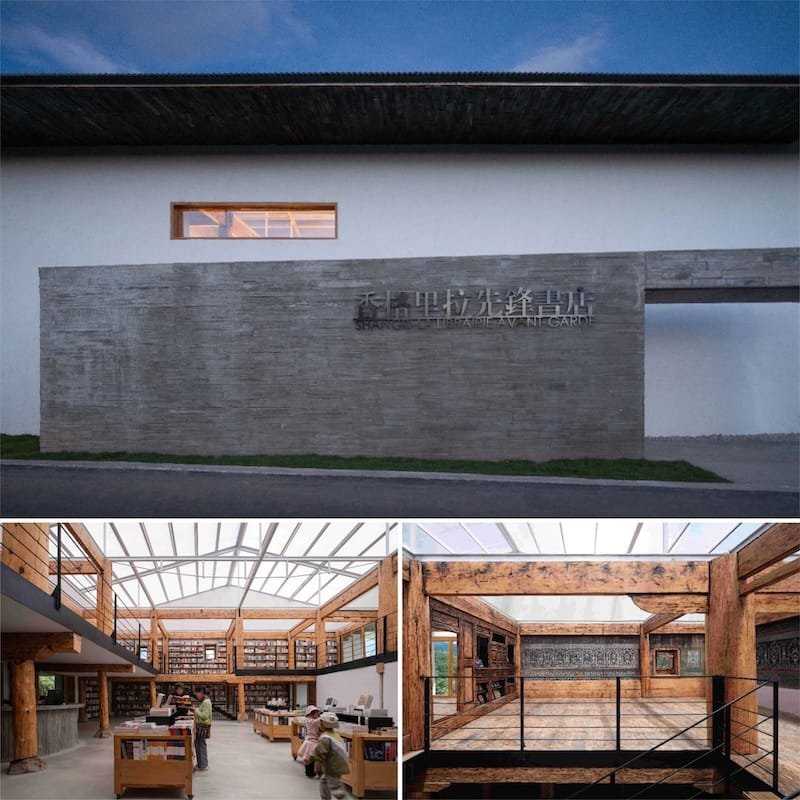
Adaptive Reuse
The Shangri-La Libraire Avant-Garde team assigned distinct functions to the three houses, from east to west: a Shangri-La Libraire Avant-Garde, a design and souvenir shop, and a café. Each was then reconfigured to suit its new role.
The Shangri-La Libraire Avant-Garde required a singular, defining space—what poet Yu Jian once called “a temple of words.” Though Wugong Village is just a half-hour’s drive from both the high-speed rail station and the expressway, Xiaozhongdian is not yet a heavily trafficked destination. Most visitors come with intention. In response, we carved out a double-height central atrium within the first house. Bookshelves line the walls, and the surrounding timber structure supports a mezzanine-level walkway, placing every book within arm’s reach.

Circulation and Landscape
On the southern façade of a typical “shanpian fang,” a small cantilevered granary box—built using interlocking timber—is inserted into the rammed-earth wall. When this granary was removed, it left a gap over three meters wide. This void inspired a concrete walkway that leads visitors from the second floor outwards, descending gradually back to the earth. This subtle intervention reorients the building’s relationship with the landscape, adding a ritual dimension to the experience—an opportunity to both feel the land and reflect on the architecture.
From a purely functional perspective, the spatial distances posed a challenge: the Shangri-La Libraire Avant-Garde and design shop are separated by 56 meters; the design shop and café by 38 meters. Creating a continuous and engaging visitor experience across these breaks was critical.
To avoid intruding on farmland, the walkway projects outward and then folds back toward the courtyard gate. From there, it traces a southern path across the fields to an open-air platform. A low wall here, likely once marking a boundary, now frames a panoramic perspective. This moment of distance allows visitors to survey the entire site—three houses in dialogue with one another, and with the land.
Next, the path leads westward toward the design shop, ascending a half-level terrace. From here, one can gaze out across the pine forests toward the distant Haba Snow Mountain. Inside the design shop, a 30-meter elevated ramp floats above a barley field, guiding guests straight to the back garden of the café. The café’s own terrace projects toward a reservoir, offering a moment of quiet contemplation before descending again—into the forest’s edge, and into deeper communion with nature.

Shangri-La Libraire Avant-Garde by Zhaoyang
cr:archdaily
